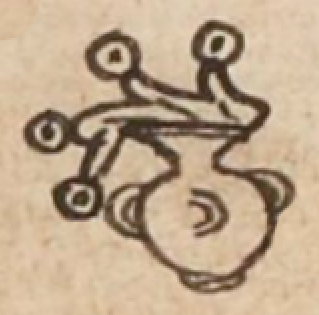Coatl (Verg8v)
This black-line drawing of the compound glyph for the personal name Coatl (“Serpent,” attested here as a man’s name), also a day name, shows a ceramic pitcher (comitl) with water pouring off to the left from the top of the jug. The stream of water has four splashes, each one with a droplet/bead at the tip. It also has lines of current (movement). The jug has three handles and a flared neck.
Stephanie Wood
Given the ecclesiastics' efforts to stifle Indigenous religious belief and practice, one might well wonder whether this fully phonetic compound intentionally replaces the well known sign of the serpent in favor of a jug of water, in order to disguise the on-going observation of naming children after the autonomous-era calendar days. The same question arises with the two glyphs for coatequitl; a single serpent would have been easier to draw than the jug and water in those cases, too.
Stephanie Wood
juan. cohuatl
Juan Coatl
Stephanie Wood
1539
Jeff Haskett-Wood
serpientes, serpents, water, agua, cerámica, barro, ceramics, jugs, cantaros, pottery, ollas, jarras

coa(tl), serpent, https://nahuatl.wired-humanities.org/content/coatl
a(tl), water, https://nahuatl.wired-humanities.org/content/atl
co(mitl), ceramic jug, https://nahuatl.wired-humanities.org/content/comitl
La Serpiente
Stephanie Wood
Codex Vergara, folio 8v, https://gallica.bnf.fr/ark:/12148/btv1b84528032/f24.item.zoom
The non-commercial reuse of images from the Bibliothèque nationale de France is free as long as the user is in compliance with the legislation in force and provides the citation: “Source gallica.bnf.fr / Bibliothèque nationale de France” or “Source gallica.bnf.fr / BnF.” We would also appreciate a citation to the Visual Lexicon of Aztec Hieroglyphs, https://aztecglyphs.wired-humanities.org/.




